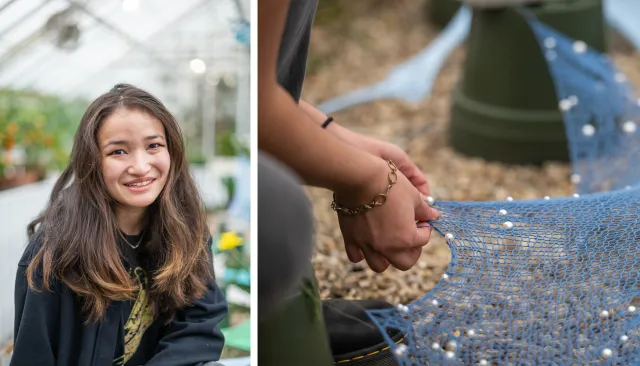Art in Bloom
by Greenhouse Horticulturist Lily Carone
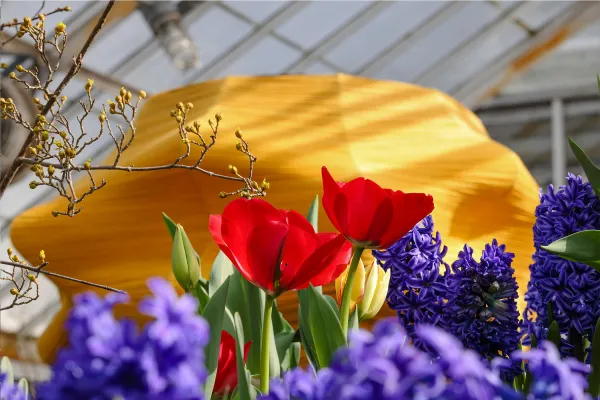
Published May 29, 2024
Leaflet 2023
In line with our mission to “facilitate collaboration” and encourage and train students to be “informed and impactful change agents,” the botanic garden was thrilled to implement a new collaborative approach to the 2023 Spring Bulb Show. Beyond its familiarly spectacular nature, this year’s show boasted the visionary imagination and interpretation of three of Smith’s studio art majors: Wells Wells ’23, Anne (Annie) Uesugi ’23 and Benjamin (Benny) Kleinman-Eddy ’23.

In addition to the work that goes into growing the bulbs—this year a whopping 8,582!—the production also requires a certain amount of creative and cerebral labor. Historically, the show has been designed around a central artistic concept that extends beyond the springtime tableau to offer a narrative contextualized in conversation with the mass of flowering bulbs, elevating and deepening the experience for our visitors. Some may remember the evocative Monet motif from 2015, or “The Evil Garden of Edward Gorey” from 2016. Year after year, these inspired displays have offered fresh and dynamic perspectives to the show.
This year, in the spirit of reinvention, innovation and putting students at the center of our work, we enlisted students to create an artistic installation for the bulb show.
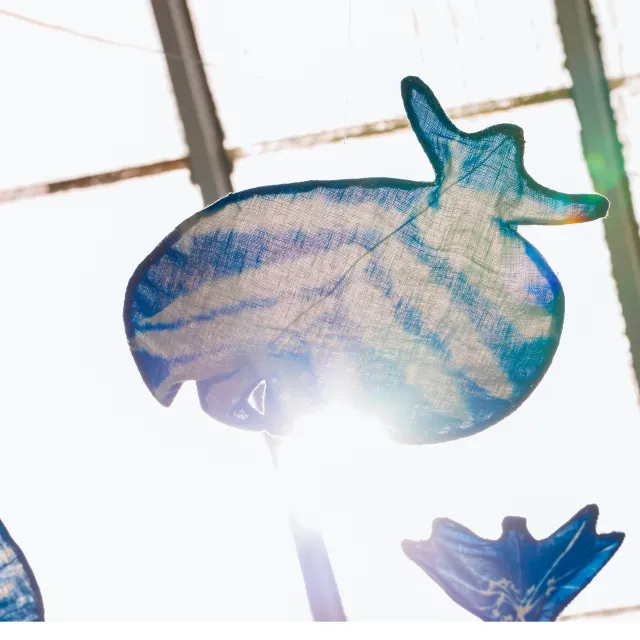
The idea to collaborate this way originated during my time at the Mount Holyoke College Botanic Garden beginning in 2018, when I invited students to produce a sculptural component for the spring bulb show. Not only did that project connect students with the botanic garden staff in a new and profound way, it also provided them with real-world experience, requiring them to work on a tight schedule while responding to site-specific demands and challenges inherent in commissioned work. Most significantly, the collaboration gave the students agency over the direction of this beloved tradition while publicly celebrating their interests and abilities.
I was eager to implement this approach at Smith, expecting that it would be a successful endeavor given the culture of creativity and cooperation here. Early in the fall of 2022, I began collaborating with Lynne Yamamoto, Jessie Wells Post Professor of Art, to commission original artwork from three senior studio art majors. After being selected and accepting the commission, Wells, Annie and Benny were provided with a prompt to initiate their interpretive process: “Given that all living things are impacted by the variable balance between light and dark, can you conceptualize a work that deals with light and darkness in a broad sense?”
In considering this question, and after conducting some research into the various bulb species that would be on display and their cultural and botanical histories, the artists focused on themes such as mythology, water and reflection, and the relationship between the concepts of above and below. The contemplation and artistic synthesis of these ideas led to a collaborative work titled Between Bloom and Breadth.
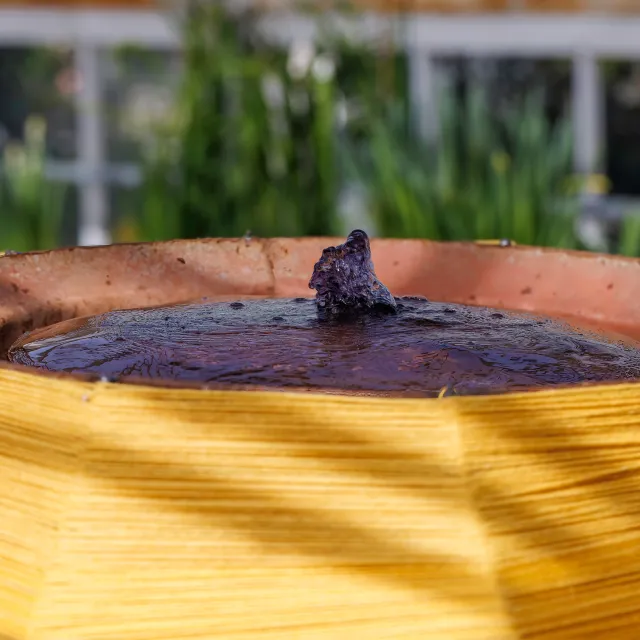
As hoped, the relationships that have grown out of this collaboration have been significant. The project engaged the students, and by extension their peers, more deeply with the horticultural work that we do, and it enriched and elevated not only the bulb show but the experience of all involved. After Wells, Annie and Benny presented their first concept proposal, Director Tim Johnson remarked enthusiastically, “These are students who we might never have met or interacted with otherwise.”
It has been incredibly rewarding to partake in this expansion of our connections across the community and to support our students’ creative pursuits. I am immensely grateful to Lynne, Wells, Annie and Benny for taking on this challenge and for sharing their time and creativity with us.
Between
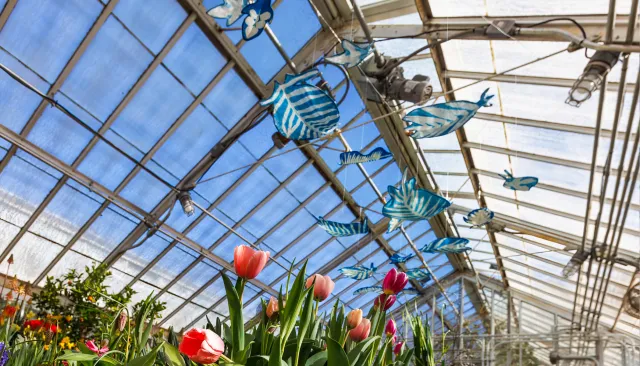
Materials: fabric, cyanotype dye, wire, embroidery floss, jump rings, fishing line
Between plant and animal. Between air and water. Between light and dark. Between fish and bird. Between sun and shadow. Between stillness and motion. Between creature and object. Between bloom and breadth. Between me and you.
Between is a collaboration between plants, sun, water, fish, birds, my fiancé and myself. I used cyanotype, a process which teaches fabric to become light sensitive, such that where the sun rays touch the surface it becomes bright blue, and where leaves shield against the sun, the fabric remains white, creating a print that resembles an inverted shadow. These imprints of something once alive became beings who swim easily between water and sky, and play among the flowers. The creatures I created converse imperceptibly with the bulbs, sharing secret formulas to turn sunlight into breath. If you listen carefully, you might be able to hear them breathing.
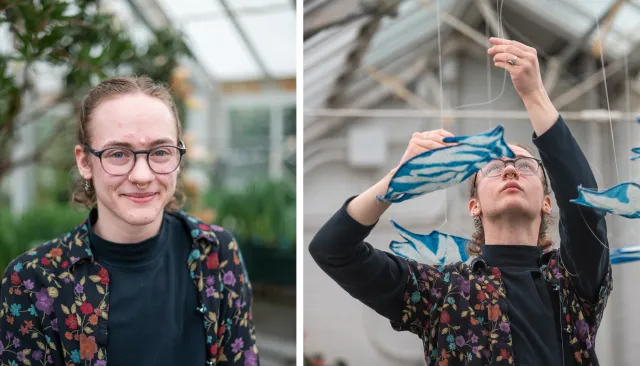
Bloom
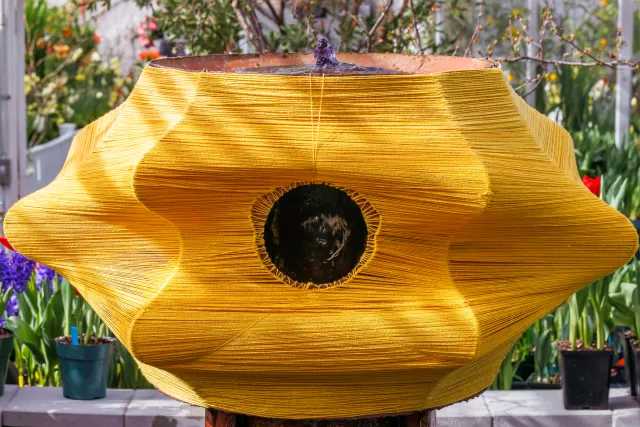
Materials: steel, 4,000 feet of yarn, lights, water
Bloom is a meditation on the time before flowering. The process of wrapping the yarn was long and monotonous; each individual strand represents a circle walked. As the piece burgeoned alongside young plants, each strand akin to a day of quiet, underground growth, the artwork and the bulb shoots reflected one another in mutual anticipation of spring—of bloom. When faced with difficult conditions, the bulb is a place of refuge. Storing food, keeping the plant alive—lying dormant until it is ready to bloom again. Through the pool, you can peek underground at this wonderful waiting period. Take time here with the bulb to wait and listen. It’s telling you that the time you spend healing—waiting for the right conditions to bloom—is worthwhile.
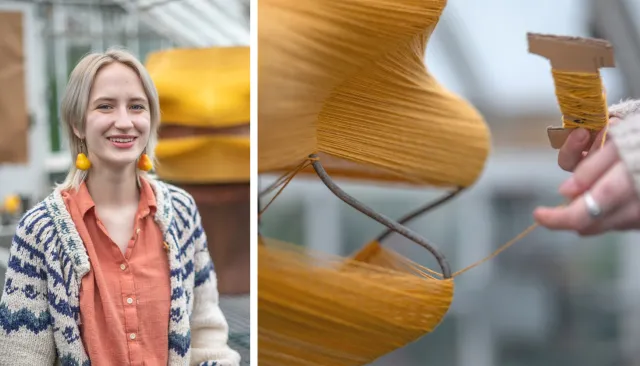
Wells welds. Raised in Rochester, New York, Wells has worked with metal sculptor John Grieco for several years. Wells has since brought a wealth of metalworking skills to their artistic practice. Employing play and joy as central tenets of the making process, Wells’ artwork investigates material relationships. They work with steel and textiles to create sculptures and installations, exploring processes of healing using the natural world as a guide.
Breadth
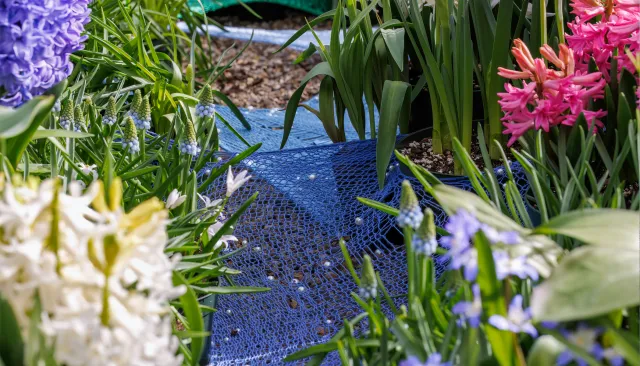
Materials: yarn, twine, pearls, fishing line
Historically, humans have always been fascinated with the fleeting beauty of flowers—the explosion of color, followed by the rapid decay of petals into sweet fruit. Tulips themselves have a reputation for being traded and sold; businessmen circulating these ornate blooms for immense profit. One of the most famous accounts of the mortal beauty of bulbs comes from the myth of poor Narcissus. Falling in love with his own reflection, realizing his inability to truly grasp his own beauty, to hold onto it tightly, caused his body to melt away, leaving behind only a single flower. This bulb show, held for many decades, is an extravagant celebration of that very fleetingness; it draws crowds out from miles to catch a glimpse of this magnificent show. And how lucky we are, to gaze into this beauty and to become like Narcissus, if only for a moment.
